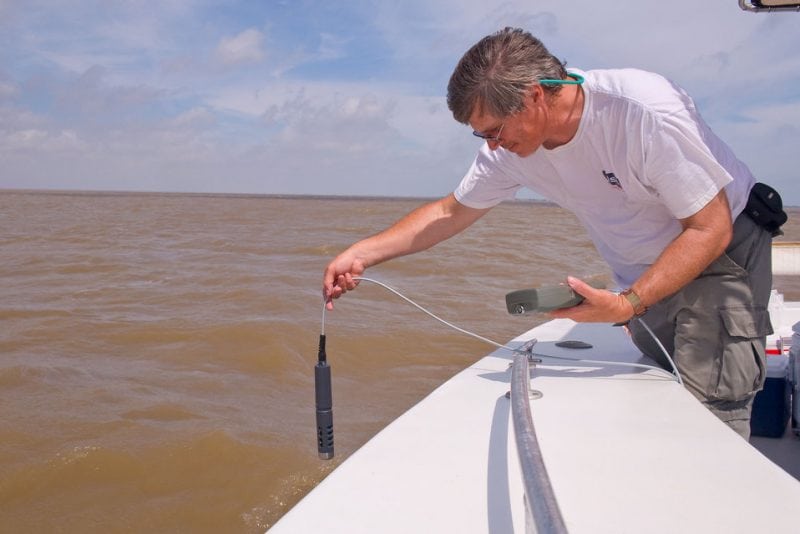
Imagine arriving at a beach on a sunny, summer day only to find that it has been closed. A sign reads, “High bacteria levels. Swimming not recommended. Increased risk of illness at this time.”
Behind the scenes, while county or state officials monitor water quality, it is likely that researchers are taking a closer look at the situation. What caused an increase in bacteria levels? Are there excessive pollutants in the water? Are criteria used by state or local government agencies sufficient to protect public health? Are there other methods of determining whether beaches and other water bodies are safe? Evaluating the health status of water bodies, which serve as natural habitats, water sources, and aquatic playgrounds for humans and wildlife is crucial in implementing policies and practices to keep everybody safe.
Fecal pollution in water bodies adversely affects human health
Fecal pollution is a common culprit when bacteria levels are elevated in water bodies, and the potential health consequences go well beyond the yuck factor. Fecal pollution conveys pathogenic microorganisms to water, which can cause diseases ranging from mild diarrhea to life-threatening cholera or hemolytic uremic syndrome. Fecal pollution from humans and other animals, such as cattle and poultry, is particularly dangerous because these fecal sources are more likely to contain human pathogens.
For over 100 years, fecal indicator bacteria (FIB) such as fecal coliforms, E. coli, and enterococci have served as state/federal regulatory tools to warn about fecal contamination. Yet, a drawback is that they provide no information about fecal source because these bacteria are widespread and abundant in the feces of most animals. Without an understanding of the source of fecal contamination, risk to human health cannot be accurately estimated, and prevention of further contamination is ineffective. One of the most frustrating deficiencies of FIB in many scenarios is the possibility that fecal contamination originates from a natural source, such as wild animals, which would suggest management actions that are very different from those required in the case of sewage pollution.
Because of these shortcomings, microbial source tracking (MST) techniques have emerged as an alternative method for identifying sources of fecal contamination in water bodies. MST markers target genes of bacteria associated with the gastrointestinal tract of species known to contribute to fecal pollution, e.g. humans, cattle, poultry, and shorebirds. These markers can help identify major sources of fecal contamination and guide management organizations toward more targeted remediation plans.
Identifying sources of fecal pollution improves management decisions
In this study, we set out to determine fecal pollution sources in a central Florida watershed managed for wildlife conservation. Given the abundance of birds within the watershed and the presence of an urban/suburban development upstream of the watershed, we used a bird-associated MST marker, GFD, and a human-associated MST marker, HF183, to distinguish between probable fecal pollution sources. For nearly three years, we collected samples of water, sediment, and vegetation each month. We quantified levels of fecal coliforms, enterococci, GFD, and HF183 from all environmental samples.
On average, sediment and vegetation harbored higher levels of FIB compared to water, which was expected and supports previous research that these environmental samples can serve as reservoirs for FIB. If sediment and vegetation periodically inundate water bodies with FIB from older fecal sources, monitoring water alone may not give an accurate portrayal of fecal pollution risk. High levels of FIB also occurred simultaneously with high densities of bird populations, especially during migratory months.
The bird associated GFD marker was consistently detected in all sample types and frequently occurred at high levels. Conversely, the human-associated marker HF183 was detected sporadically and at low levels. Further testing found that fecal samples from local deer tested positive for the human-associated marker. Predictive modeling confirmed that environmental sample type is the best predictor of FIB levels while temporal factors (i.e. month and year) were more important in predicting MST marker levels. Overall, the evidence provided by using both FIB and MST markers led us to the conclusion that birds, not humans, were a major contributor of fecal pollution in the watershed.
Maintaining water quality in the future
Water quality is a growing issue, especially as the global human population continues to expand and natural disasters threaten existing water sources. The recent impact of Hurricane Florence on pork and poultry farms in the Carolinas is one example of why new approaches for monitoring quality are urgently needed. Given the results found in this study, the concomitant use of FIB and MST techniques may provide direction in maintaining and improving water quality over time.
These findings are described in the article entitled, Determination of wild animal sources of fecal indicator bacteria by microbial source tracking (MST) influences regulatory decisions, recently published in the journal Water Research. The work was conducted by Karena H. Nguyen, Caroline Senay, Suzanne Young, Bina Nayak, Aldo Lobos, James Conrad, and Valerie J. Harwood from the Integrative Biology Department at the University of South Florida in Tampa, FL.









